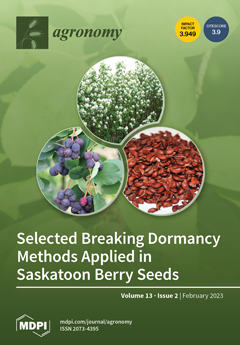Pendimethalin herbicide toxicity to rice plants and barnyard grass invasion have increasingly affected the productivity of direct-seeded rice (DSR) in the fields. Whether and how to promote DSR productivity and sustain weed management depend on the appropriate pre-emergence herbicide application rate to minimise its toxicity in the rice ecosystem. Pot experiments were conducted to determine the effects of pendimethalin rates (1.5, 1.75, 2.0 kg a.i. ha
−1, two control treatments include the untreated control and the treated control with 1.5 kg a.i. ha
−1 S-metolachlor) on barnyard grass (
Echinochloa crus-galli (L.) Beaux) and their potential toxicity risk to photosynthetic performances of rice (
Topaz and
Sen pidao). All the pendimethalin treatments provided excellent control of barnyard grass. Among the treatments, 1.5, 1.75, 2.0 kg a.i. ha
−1 pendimethalin and 1.5 kg a.i. ha
−1 S-metolachlor (treated control) decreased leaf area of barnyard grass significantly by 38.9, 49.6, 49.6 and 46.2%, respectively, compared with the untreated control at 40 days after sowing (DAS). The above-ground biomass of barnyard grass significantly decreased by 40% (1.48 g plant
−1) with 2.0 kg a.i. ha
−1 pendimethalin and by 46.2% (1.33 g plant
−1) when 1.5 kg a.i. ha
−1S-metolachlor was applied at 40 DAS compared with the untreated pots. Higher pendimethalin rates increased toxicity in
Topaz and
Sen pidao varieties, and 2.0 kg a.i. ha
−1 pendimethalin significantly reduced effective quantum yield (light-adapted) of photosystem (PS) II by 18% (0.58) and 19% (0.52), respectively, compared with the untreated control. Application of 2.0 kg a.i. ha
−1 pendimethalin rate significantly decreased the maximum quantum yield (dark-adapted) of
Sen pidao (0.66) compared with 1.5 kg a.i. ha
−1 pendimethalin (0.68) including the untreated control. All pendimethalin treatments suppressed above-ground biomass at 55 DAS, but above-ground biomass of barnyard grass significantly decreased by 59.9% when 2.0 kg a.i. ha
−1 pendimethalin was applied compared with the untreated control. Although application of 1.5 kg a.i. ha
−1 pendimethalin rates reduced the effective quantum yield (light-adapted) of photosystem II of
Sen pidao (0.55) by a small percentage (8%) than
Topaz (0.65), it was non-toxic for both varieties compared with 2.0 kg a.i. ha
−1 pendimethalin. Therefore, the use of 1.5 kg a.i. ha
−1 pendimethalin can be used for effective weed management in the direct seeding of rice at an early growth stage.
Full article





